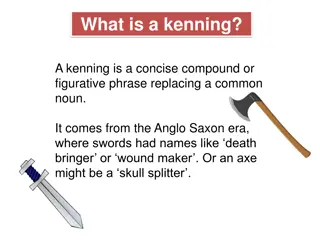Connections, Succession, and Trade: Insights into Anglo-Saxon England
Anglo-Saxon England in 1066 was a centralized, efficient kingdom vulnerable to invasion. Professor Stephen Baxter discusses the attractive nature of the society to invaders due to its centralization and wealth. The family tree of the Kings of England reveals intricate connections, successions, and alliances during this period. The surviving sources provide valuable insights into the history of England, its politics, and trade relationships with Scandinavia and Normandy.
Download Presentation

Please find below an Image/Link to download the presentation.
The content on the website is provided AS IS for your information and personal use only. It may not be sold, licensed, or shared on other websites without obtaining consent from the author.If you encounter any issues during the download, it is possible that the publisher has removed the file from their server.
You are allowed to download the files provided on this website for personal or commercial use, subject to the condition that they are used lawfully. All files are the property of their respective owners.
The content on the website is provided AS IS for your information and personal use only. It may not be sold, licensed, or shared on other websites without obtaining consent from the author.
E N D
Presentation Transcript
What sort of England did William conquer? What sort of England did William conquer?
Anglo-Saxon England in 1066 was efficient, powerful, centralised and rich. This made it attractive to an invader and its lively, centralised, complicated politics led to weaknesses that made it vulnerable to invasion. Professor Stephen Baxter, St Peter s College, University of Oxford
You have a map and a family tree. What can you infer about The connections of the Kings of England? The way succession* worked at the time? * Succession = who the throne passes to when a monarch (king or queen) dies. How the people around York (Jorvik) may have been different to the people of southern England?
How can the surviving sources be used to support historians assertions?
What conclusions do historians draw from these sources?
What sort of What sort of England did England did William conquer? William conquer?
A few reading ideas James Campbell: The Anglo-Saxon State James Campbell: The Anglo-Saxons Henry Mayr-Harting: The Coming of Christianity to Anglo-Saxon England Marc Morris: The Norman Conquest Michael Wood: In Search of the Dark Ages
Trade routes Scandinavia Norway Denmark How did people trade? Which English cities were most important for trade with Scandinavia? Normandy Which English people would have more links with Normandy?
Kings of England 959-1066 Swein, (King of Denmark) and King of England 1013-14 Edgar, King of England 959-975 Canute, King of England 1016-35 m1 Ethelred, King of England Aelfgifu of Northampton 978-1013 and 1014-1016 m2 Emma of Normandy m1 m2 Aelfgifu of Jorvik (York) (and King of Denmark and Norway) (succeeded his brother Edward who was King 975-8) Harthacnut, King of England (and King of Denmark) Edmund Ironside, King of England Edward the Confessor, King of England Harold I Harefoot , King of England 1016 1042-1066 1035-40 1040-42 Descendent Matilda would eventually marry King Henry I son of William the Conqueror, nephew of Emma of Normandy























